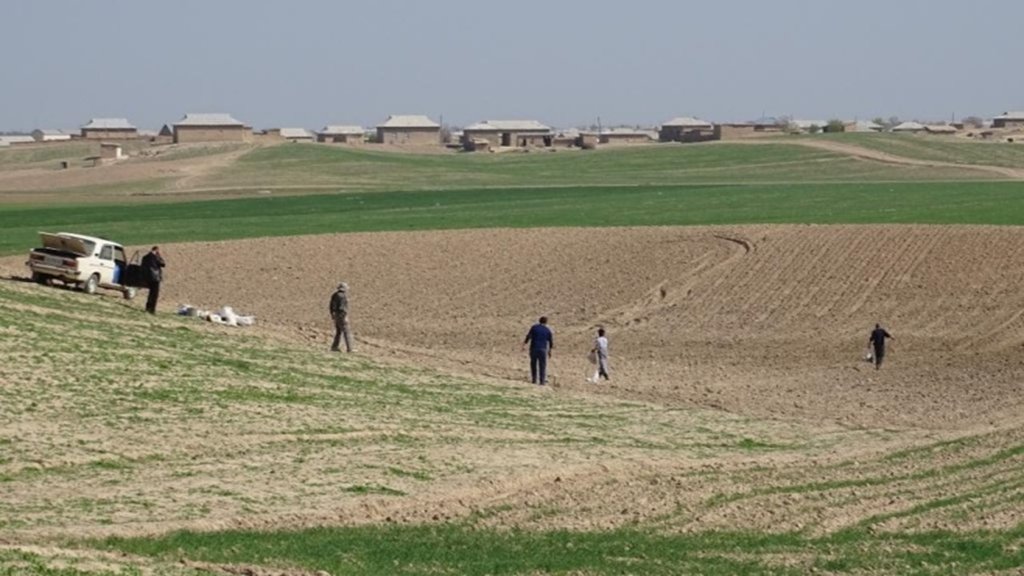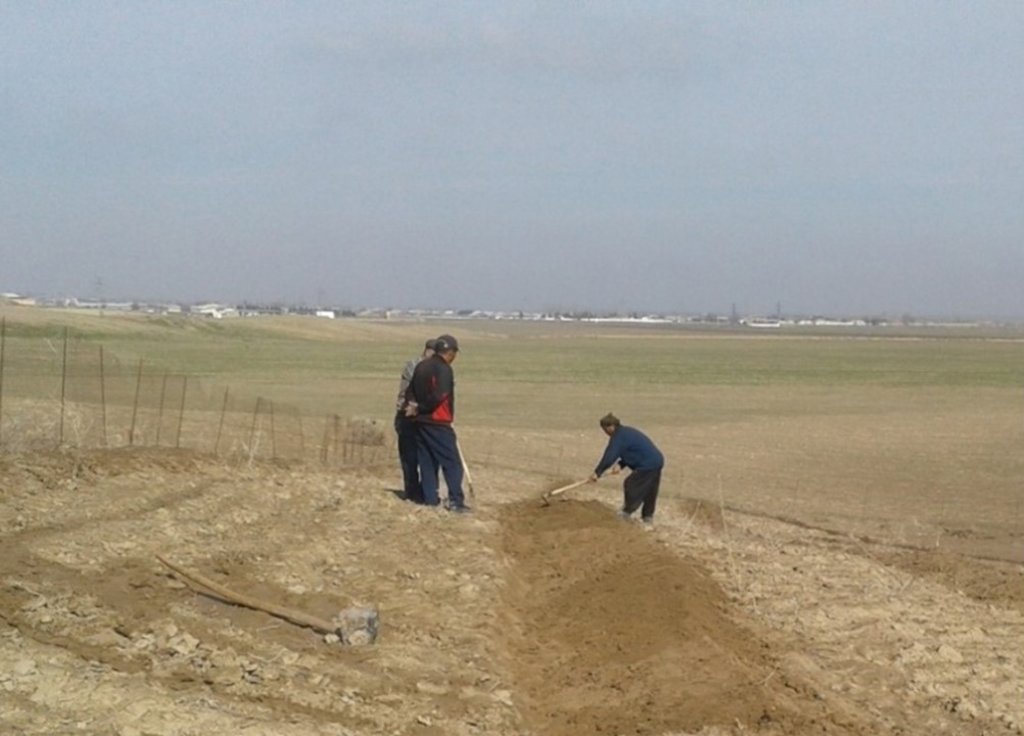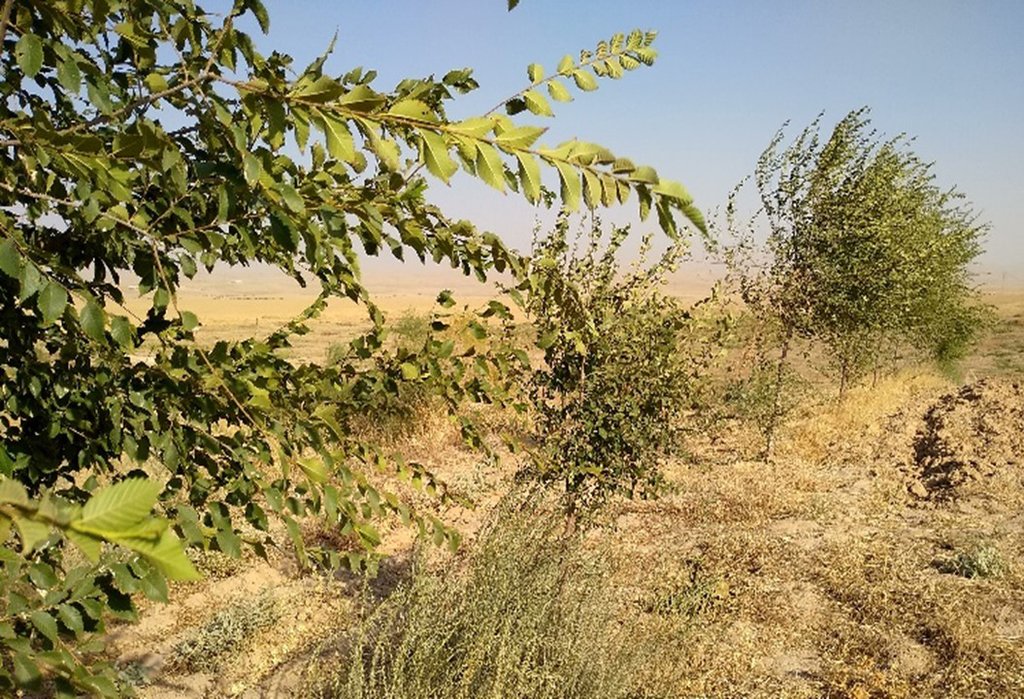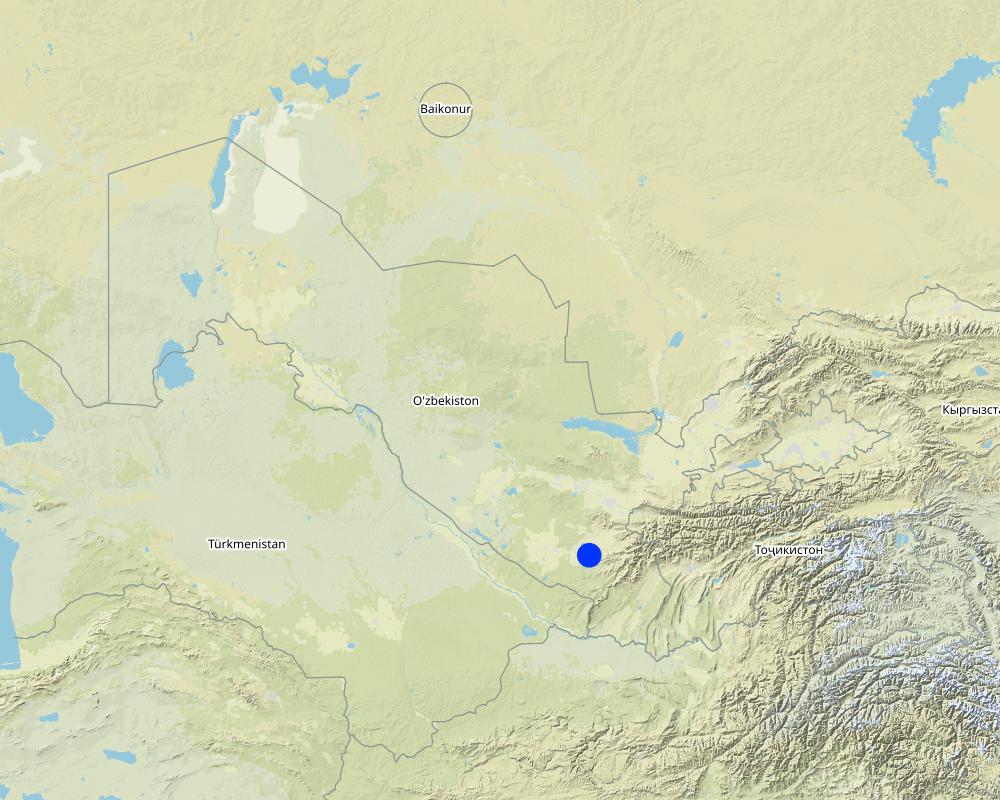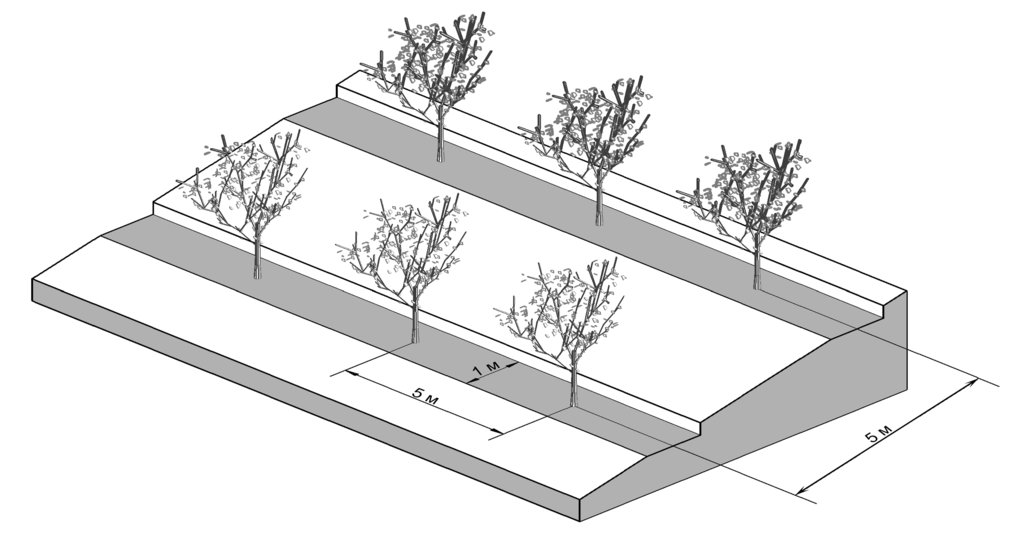Агролесомелиорация богарных земель [Uzbekistan]
- Creation:
- Update:
- Compiler: Rustam Ibragimov
- Editor: –
- Reviewer: Olga Andreeva
Агролесомелиорация богарных земель
technologies_6209 - Uzbekistan
View sections
Expand all Collapse all1. General information
1.2 Contact details of resource persons and institutions involved in the assessment and documentation of the Technology
Key resource person(s)
SLM specialist:
Мукимов Толиб, Худайкулович
Научно-исследовательский институт Каракулеводства и экологии пустынь, Самарканд
Uzbekistan
land user:
Олтинбоев Шерзод
Фермерское хозяйство «Олтынбоев ери», Кашкадарьинская область, Камашинский район
Uzbekistan
Name of project which facilitated the documentation/ evaluation of the Technology (if relevant)
Integrated natural resources management in drought-prone and salt-affected agricultural production landscapes in Central Asia and Turkey ((CACILM-2))Name of the institution(s) which facilitated the documentation/ evaluation of the Technology (if relevant)
Design and Research UZGIP Institute, Ministry of Water Resources (UzGIP) - Uzbekistan1.3 Conditions regarding the use of data documented through WOCAT
The compiler and key resource person(s) accept the conditions regarding the use of data documented through WOCAT:
Ja
1.4 Declaration on sustainability of the described Technology
Is the Technology described here problematic with regard to land degradation, so that it cannot be declared a sustainable land management technology?
Nee
2. Description of the SLM Technology
2.1 Short description of the Technology
Definition of the Technology:
Создание насаждений из засухоустойчивых древесных пород на склоновых богарных землях обеспечит повышение продуктивности богарных земель и доходов местного населения. Локальное облесение богарной пашни предоставит экологические выгоды - снижение рисков водной эрозии, смягчение воздействия изменения климата путем секвестрации СО2 в древесной биомассе и почве, а также способствует общему оздоровлению окружающей среды.
2.2 Detailed description of the Technology
Description:
Данная технология была внедрена в рамках проекта ГЭФ/ФАО «Поддержка решений по продвижению и распространению устойчивого использования земельных ресурсов» (DS-SLM) (2015-2018) на участке богарной пашни в Камашинском районе Кашкадарьинской области. Богарные пахотные земли в Узбекистане, занимающие площадь около 743тыс.га, расположены в предгорной зоне на адырах. Склоны богарных угодий подвергаются водной эрозии, что требует особых приемов и специальных мероприятий при выращивании культур для сохранения верхнего плодородного слоя почвы и влагосбережения. Технология агролесомелиорации богарной пашни представляет собой создание участков насаждений из засухоустойчивых древесных пород на небольших террасах.
Технология включает следующие мероприятия:
1.Проводится традиционная подготовка земли - вспашка, боронование, малование
2.Выполняется поделка мелких террас ручным способом с уклоном, противоположным уклону склона, шириной 1м и с расстоянием между террасами 5 м
3. Изолированный участок агролесничества огораживают металлической сеткой или другим способом, чтобы предотвратить повреждение скотом.
4. Весной (в марте ) проводится посадка саженцев по схеме 5 х 5 м.
5.Дальнейшие мероприятия включают уход за посадками:
- примитивный капельный полив с помощью полиэтиленовых баклажек (первые 2-3года).
- внесение удобрений (навоз, компосты),
- мероприятия по борьбе с вредителями и болезнями. Ранней весной (до появления почек) проводят обработку деревьев против вредителей медным купоросом из расчета 100-150 грамм на 10л воды. В марте проводят побелку ствола известью. Против корнегрызущих гусениц жуков междурядья обрабатывают 57% препаратом фуфанон 0,6-1,0 л/га, или 30% препаратом бензофосфата из расчета 2,0-2,3 кг/га.
Стоимость внедрения технологии достаточно высокая - порядка 1200 долл.США, что является сдерживающим фактором для ее широкого распространения. Основные затраты относятся к начальному периоду – поделке террас, приобретению и посадке саженцев. В дальнейшем затраты снижаются – отпадает потребность в поливе, снижается засоренность в результате конкуренции с подросшими деревьями.
Особенностью богарных условий на территории применения технологии является низкая обеспеченность осадками. Климат и погода обусловливают низкую и неустойчивую урожайность озимой пшеницы, которая традиционно выращивается на богарных землях. Для повышения продуктивности богары в настоящее время расширяются площади под засухоустойчивыми видами культур, такими, как софлор. Поиск альтернативных решений и поддержка местного сообщества, основное занятие которого богарное земледелие и скотоводство, имеет первостепенное значение для повышения уровня жизни и благосостояния.
2.3 Photos of the Technology
2.5 Country/ region/ locations where the Technology has been applied and which are covered by this assessment
Country:
Uzbekistan
Region/ State/ Province:
Камашинский район/Кашкадарьинская область
Further specification of location:
г. Камаши
Specify the spread of the Technology:
- applied at specific points/ concentrated on a small area
Is/are the technology site(s) located in a permanently protected area?
Nee
Map
×2.6 Date of implementation
Indicate year of implementation:
2015
If precise year is not known, indicate approximate date:
- less than 10 years ago (recently)
2.7 Introduction of the Technology
Specify how the Technology was introduced:
- through projects/ external interventions
3. Classification of the SLM Technology
3.1 Main purpose(s) of the Technology
- reduce, prevent, restore land degradation
- preserve/ improve biodiversity
- mitigate climate change and its impacts
3.2 Current land use type(s) where the Technology is applied
Land use mixed within the same land unit:
Nee

Cropland
- Annual cropping
3.3 Has land use changed due to the implementation of the Technology?
Has land use changed due to the implementation of the Technology?
- Yes (Please fill out the questions below with regard to the land use before implementation of the Technology)
Land use mixed within the same land unit:
Ja
Specify mixed land use (crops/ grazing/ trees):
- Agroforestry

Cropland
- Annual cropping
Annual cropping - Specify crops:
- oilseed crops - sunflower, rapeseed, other
3.4 Water supply
Water supply for the land on which the Technology is applied:
- rainfed
3.5 SLM group to which the Technology belongs
- agroforestry
- improved ground/ vegetation cover
- cross-slope measure
3.6 SLM measures comprising the Technology

vegetative measures
- V1: Tree and shrub cover

structural measures
- S1: Terraces

management measures
- M1: Change of land use type
3.7 Main types of land degradation addressed by the Technology

soil erosion by water
- Wt: loss of topsoil/ surface erosion

soil erosion by wind
- Et: loss of topsoil

biological degradation
- Bc: reduction of vegetation cover
3.8 Prevention, reduction, or restoration of land degradation
Specify the goal of the Technology with regard to land degradation:
- reduce land degradation
4. Technical specifications, implementation activities, inputs, and costs
4.1 Technical drawing of the Technology
Technical specifications (related to technical drawing):
Ручным способом создают небольшие террасы с противоположным к склону уклоном. Смешанные древесные породы (плодовые - миндаль и декоративные – кайрагач и др.) высаживаются на подготовленных ручным способом мелких террасах. Схема посадки деревьев: 5 х 5м. Ширина террас: 1м, расстояние между террасами 5м.
4.2 General information regarding the calculation of inputs and costs
Specify how costs and inputs were calculated:
- per Technology area
Indicate size and area unit:
1 гектар
Specify currency used for cost calculations:
- USD
Indicate average wage cost of hired labour per day:
около 10 долл. США
4.3 Establishment activities
| Activity | Timing (season) | |
|---|---|---|
| 1. | Вспашка, малование, боронование | февраль |
| 2. | Ручная поделка террас | февраль |
| 3. | Огораживание участка | февраль |
| 4. | Посадка саженцев | февраль-март |
| 5. | Поливы для приживаемости саженцев | март-октябрь |
Comments:
Все мероприятия необходимо проводить в сжатые сроки, чтобы закончить посадку ранней весной (конец февраля - начало марта, в зависимости от погоды) для максимального использования благоприятных погодных условий
4.4 Costs and inputs needed for establishment
| Specify input | Unit | Quantity | Costs per Unit | Total costs per input | % of costs borne by land users | |
|---|---|---|---|---|---|---|
| Labour | Труд рабочих (поделка террас, посадка, уход за деревьями) | га | 1.0 | 436.0 | 436.0 | |
| Equipment | Использование машин (вспашка, боронование, малование) | га | 1.0 | 87.0 | 87.0 | |
| Plant material | Саженцы | шт | 280.0 | 3.0 | 840.0 | |
| Construction material | Огораживание участка стальной сеткой | 1.0 | 349.0 | 349.0 | ||
| Total costs for establishment of the Technology | 1712.0 | |||||
| Total costs for establishment of the Technology in USD | 1712.0 | |||||
If land user bore less than 100% of costs, indicate who covered the remaining costs:
Проектом
4.5 Maintenance/ recurrent activities
| Activity | Timing/ frequency | |
|---|---|---|
| 1. | Уход за посевами (полив из баклажек первые 2 года) | вегетация |
| 2. | Борьба с вредителями: - обработка препаратами (медный купорос, фуфанон, бензофосфат) | Ранней весной до набухания почек |
| 3. | Борьба с вредителями: - побелка стволов известью | в течение вегетации по потребности |
4.6 Costs and inputs needed for maintenance/ recurrent activities (per year)
| Specify input | Unit | Quantity | Costs per Unit | Total costs per input | % of costs borne by land users | |
|---|---|---|---|---|---|---|
| Labour | Труд рабочего по уходу за деревьями | га | 1.0 | 200.0 | 200.0 | 100.0 |
| Equipment | Использование машин | га | 1.0 | 60.0 | 60.0 | 100.0 |
| Other | Охрана участка | га | 1.0 | 60.0 | 60.0 | 100.0 |
| Total costs for maintenance of the Technology | 320.0 | |||||
| Total costs for maintenance of the Technology in USD | 320.0 | |||||
Comments:
Затраты на посадку деревьев используются в 1 год внедрения технологии, в дальнейшем затраты включают стоимость ухода за насаждениями, замену высохших деревьев и охрану.
4.7 Most important factors affecting the costs
Describe the most determinate factors affecting the costs:
Наибольшие затраты относятся к поделке террас, приобретению саженцев и огораживанию участка. Однако, огораживание участка может быть выполнено другим, более дешевым способом, вместо металлической сетки используя др. материал
5. Natural and human environment
5.1 Climate
Annual rainfall
- < 250 mm
- 251-500 mm
- 501-750 mm
- 751-1,000 mm
- 1,001-1,500 mm
- 1,501-2,000 mm
- 2,001-3,000 mm
- 3,001-4,000 mm
- > 4,000 mm
Specify average annual rainfall (if known), in mm:
327.00
Specifications/ comments on rainfall:
Продолжительность вегетационного периода естественной растительности составляет 90 дней
Indicate the name of the reference meteorological station considered:
Камаши
Agro-climatic zone
- semi-arid
Продолжительность вегетационного периода (ПВП) - период, в течение которого количество выпадающих осадков составляет не менее половины суммарной испаряемости и средняя температура выше 6,5°C
5.2 Topography
Slopes on average:
- flat (0-2%)
- gentle (3-5%)
- moderate (6-10%)
- rolling (11-15%)
- hilly (16-30%)
- steep (31-60%)
- very steep (>60%)
Landforms:
- plateau/plains
- ridges
- mountain slopes
- hill slopes
- footslopes
- valley floors
Altitudinal zone:
- 0-100 m a.s.l.
- 101-500 m a.s.l.
- 501-1,000 m a.s.l.
- 1,001-1,500 m a.s.l.
- 1,501-2,000 m a.s.l.
- 2,001-2,500 m a.s.l.
- 2,501-3,000 m a.s.l.
- 3,001-4,000 m a.s.l.
- > 4,000 m a.s.l.
Indicate if the Technology is specifically applied in:
- not relevant
Comments and further specifications on topography:
520 м над у.м, крутизна склонов 8-16%
5.3 Soils
Soil depth on average:
- very shallow (0-20 cm)
- shallow (21-50 cm)
- moderately deep (51-80 cm)
- deep (81-120 cm)
- very deep (> 120 cm)
Soil texture (topsoil):
- fine/ heavy (clay)
Soil texture (> 20 cm below surface):
- fine/ heavy (clay)
Topsoil organic matter:
- low (<1%)
5.4 Water availability and quality
Ground water table:
5-50 m
Availability of surface water:
poor/ none
Water quality (untreated):
good drinking water
Water quality refers to:
ground water
Is water salinity a problem?
Nee
Is flooding of the area occurring?
Nee
Comments and further specifications on water quality and quantity:
В богарной зоне отсутствуют поверхностные источники питьевой воды. Для питья используют подземную воду из скважин или привозную
5.5 Biodiversity
Species diversity:
- low
Habitat diversity:
- low
Comments and further specifications on biodiversity:
Богарная зона земледелия характеризуется бедным видовым разнообразием из-за недостатка естественного увлажнения. Основные культуры богары – оз.пшеница и ячмень, софлор, подсолнечник. К концу лета поверхность почвы становится практически оголенной, без растительности
5.6 Characteristics of land users applying the Technology
Sedentary or nomadic:
- Sedentary
Market orientation of production system:
- mixed (subsistence/ commercial)
Off-farm income:
- > 50% of all income
Relative level of wealth:
- average
Individuals or groups:
- individual/ household
Level of mechanization:
- mechanized/ motorized
Gender:
- men
Age of land users:
- middle-aged
5.7 Average area of land used by land users applying the Technology
- < 0.5 ha
- 0.5-1 ha
- 1-2 ha
- 2-5 ha
- 5-15 ha
- 15-50 ha
- 50-100 ha
- 100-500 ha
- 500-1,000 ha
- 1,000-10,000 ha
- > 10,000 ha
Is this considered small-, medium- or large-scale (referring to local context)?
- medium-scale
Comments:
Средняя площадь фермерских хозяйств - в пределах 100га, арендованной у государства сроком на 50 лет. Площадь дехканских хозяйств – в пределах 0,35 га с частной собственностью на землю и правом купли-продажи и передачи по наследству
5.8 Land ownership, land use rights, and water use rights
Land ownership:
- state
- individual, titled
Land use rights:
- leased
- individual
Water use rights:
- individual
Are land use rights based on a traditional legal system?
Ja
5.9 Access to services and infrastructure
health:
- poor
- moderate
- good
education:
- poor
- moderate
- good
technical assistance:
- poor
- moderate
- good
employment (e.g. off-farm):
- poor
- moderate
- good
markets:
- poor
- moderate
- good
energy:
- poor
- moderate
- good
roads and transport:
- poor
- moderate
- good
drinking water and sanitation:
- poor
- moderate
- good
financial services:
- poor
- moderate
- good
6. Impacts and concluding statements
6.1 On-site impacts the Technology has shown
Socio-economic impacts
Production
product diversity
Water availability and quality
irrigation water availability
Income and costs
farm income
diversity of income sources
Ecological impacts
Soil
soil cover
Biodiversity: vegetation, animals
Vegetation cover
plant diversity
Climate and disaster risk reduction
emission of carbon and greenhouse gases
micro-climate
6.2 Off-site impacts the Technology has shown
damage on public/ private infrastructure
6.3 Exposure and sensitivity of the Technology to gradual climate change and climate-related extremes/ disasters (as perceived by land users)
Gradual climate change
Gradual climate change
| Season | increase or decrease | How does the Technology cope with it? | |
|---|---|---|---|
| annual temperature | increase | well | |
| seasonal temperature | summer | increase | not well |
| annual rainfall | decrease | not well | |
| seasonal rainfall | spring | decrease | not well at all |
| seasonal rainfall | summer | decrease | moderately |
| seasonal rainfall | autumn | decrease | not well at all |
Climate-related extremes (disasters)
Climatological disasters
| How does the Technology cope with it? | |
|---|---|
| drought | moderately |
Other climate-related consequences
Other climate-related consequences
| How does the Technology cope with it? | |
|---|---|
| extended growing period | very well |
6.4 Cost-benefit analysis
How do the benefits compare with the establishment costs (from land users’ perspective)?
Short-term returns:
negative
Long-term returns:
positive
How do the benefits compare with the maintenance/ recurrent costs (from land users' perspective)?
Short-term returns:
negative
Long-term returns:
positive
Comments:
Долгосрочные положительные выгоды: сохранение и повышение биоразнообразия, повышение доходов населения, занятость
6.5 Adoption of the Technology
- single cases/ experimental
Of all those who have adopted the Technology, how many did so spontaneously, i.e. without receiving any material incentives/ payments?
- 0-10%
6.6 Adaptation
Has the Technology been modified recently to adapt to changing conditions?
Nee
6.7 Strengths/ advantages/ opportunities of the Technology
| Strengths/ advantages/ opportunities in the land user’s view |
|---|
| Дополнительный источник доходов |
| Strengths/ advantages/ opportunities in the compiler’s or other key resource person’s view |
|---|
| Дополнительный источник дохода |
| Улучшение окружающего агроландшафта |
| Предотвращение эрозии |
6.8 Weaknesses/ disadvantages/ risks of the Technology and ways of overcoming them
| Weaknesses/ disadvantages/ risks in the land user’s view | How can they be overcome? |
|---|---|
| Высокая стоимость внедрения и длительный период ожидания выгод. | Воспользоваться кредитом, искать дополнительные источники дохода на период пока технология начнет приносить доход |
| Отсутствие информации | Проводить обучение, тренинги |
| Weaknesses/ disadvantages/ risks in the compiler’s or other key resource person’s view | How can they be overcome? |
|---|---|
| Длительный период ожидания выгод | Воспользоваться кредитом, искать дополнительные источники дохода на период пока технология начнет приносить доход |
7. References and links
7.1 Methods/ sources of information
- field visits, field surveys
- interviews with land users
опрошено 4 чел
- interviews with SLM specialists/ experts
3 чел
- compilation from reports and other existing documentation
Отчетов «Decision Support for Mainstreaming and Scaling up of Sustainable Land Management» (DS-SLM)
Comments:
Полевые обследования были выполнены в 2015-2017гг.
7.2 References to available publications
Title, author, year, ISBN:
Хамзина Т.И. и др. ПРАКТИКИ И ТЕХНОЛОГИИ ДЛЯ УСТОЙЧИВОГО ИСПОЛЬЗОВАНИЯ ОРОШАЕМЫХ И БОГАРНЫХ ЗЕМЕЛЬ, ПОДВЕРЖЕННЫХ ЗАСОЛЕНИЮ И ЗАСУХЕ 2017
Available from where? Costs?
Сборник научно-практической конференции. Ташкент
Links and modules
Expand all Collapse allLinks
No links
Modules
No modules



